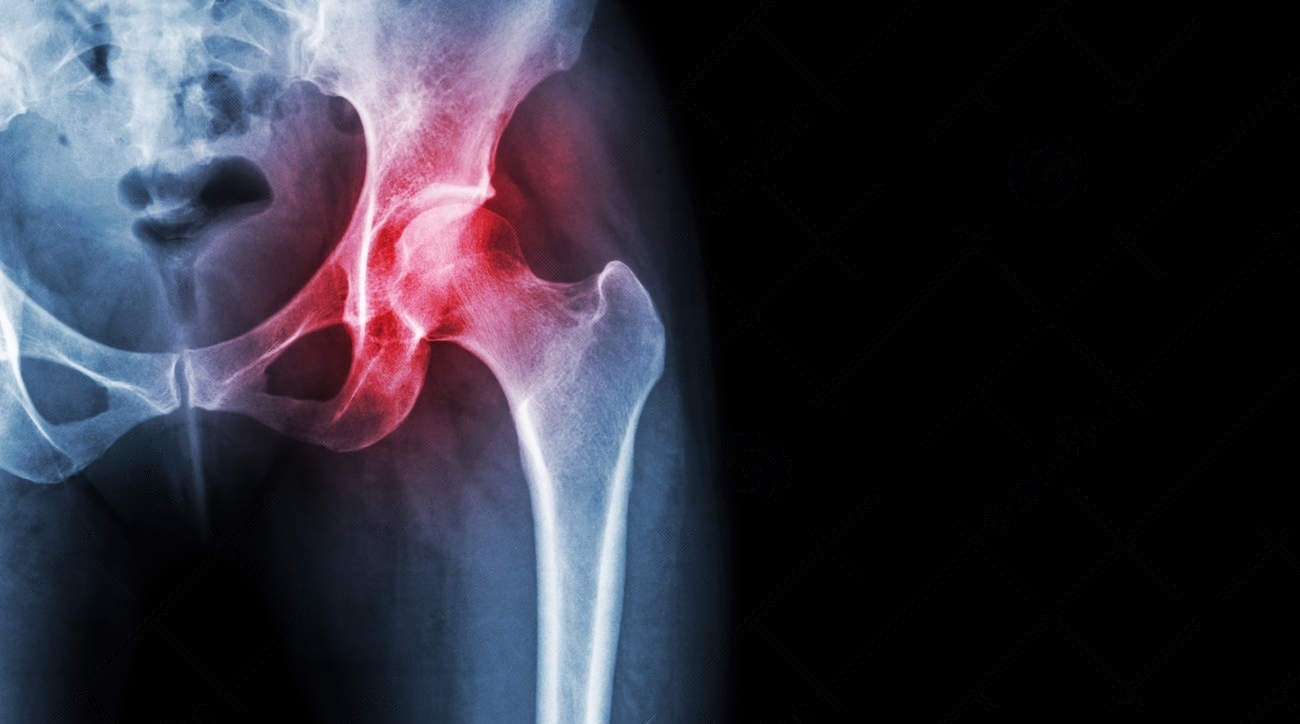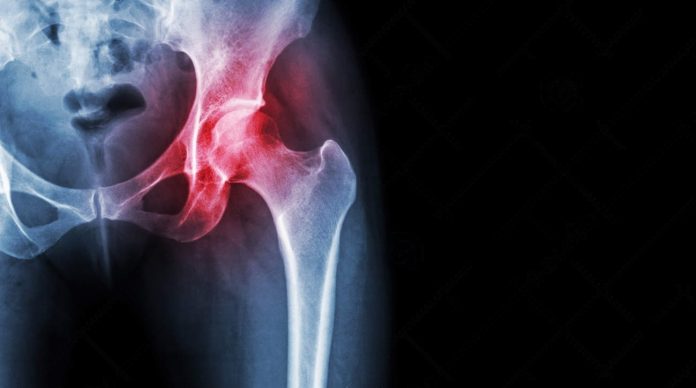Avascular necrosis (AVN) is a slow bone degeneration disorder caused by a lack of blood supply.
The loss of tissue function due to insufficient blood supply is known as avascular necrosis (AVN).
The avascular component of necrosis refers to a lack of blood flow, while the decay component simply refers to deterioration.
For example, osteonecrosis is another name for AVN. The breakdown of bone is particularly noticeable. The hip joint is the most common site of AVN, but the disease can affect any bone.
To be clear, AVN and Asthi-Majja GataVata have no causal relationship; nonetheless, the clinical manifestations of Vata Pradhana Tridoshaja Vyadhi are linked to the Vikruti of Asthi-Majja Dhatu.
Among the three ayurvedic doshas, Vata is the most prominent in the expression of AVN. Bones are the home of Vata dosha, and when Vata dosha levels rise, tissue breakdown in the bones begins, ushering in the AVN symptoms we know and fear. In addition, Pitta dosha, which lives in the blood, contributes to the pathophysiology of AVN. Because blood flow is restricted in AVN, and pitta cannot accumulate to harmful levels there, bone deterioration sets in. In addition, Kapha dosha exacerbates the inequitable formation of fatty tissues and the obstruction of the channels that carry blood to the bones.
According to Ayurveda, the best way to cure avascular necrosis is to restore harmony to the doshas and flush out any toxins that may have clogged the channels that provide blood to the affected area.
Traumatic and idiopathic AVN are the two most common types.
Traumatic avascular necrosis occurs when the blood supply to a bone is cut off, as in the case of a break or dislocation. Most often, this occurs when a hip fracture causes the hip to no longer sit properly within the joint.
Femoral AVN occurs when the arteries that supply the femoral head are injured, as can happen during a femoral neck dislocation or a sub-capital fracture (close to the head). Because of this, necrosis develops in the femoral head due to a lack of nourishment. The other kind involves a blockage in the arteries whose source is unknown. The pain of varied degrees and alterations in gait are detected later on after it has been asymptomatic for a while.
Avascular necrosis of the bone that was not caused by trauma occurs when the blood supply to the bones is cut off for any number of reasons. Non-traumatic avascular necrosis commonly strikes identical bones on opposite sides of the body. It is likely that if you have avascular necrosis in your right shoulder, you will also get it in your left shoulder. Medical disorders include osteoporosis, sickle cell anemia, diabetes, cancer, lupus, HIV, and organ transplants are the most common causes. Any places with a skeleton and a circulatory system are potential AVN hotspots. Osteonecrosis is a condition that affects the epiphyseal ends of long bones like the femur and humerus. There are other examples of small bones where this might occur, such as the calcaneum in the heel and the lunate and scaphoid in the wrist joint.

Some of the most common AVN occurrences include:
- The joint between the hip with the femur head
- Shoulder/Humeral Head Arthritis Joint
- The anatomical term for a bone located in the wrist joint is also known as a lunate bone.
- Scaphoid, or bone of the ankle joint
- Anatomical Structure of the Knee and Distal Femur
In addition to these areas, AVN has been shown to spread to the jaw, sesamoid bone, navicular bone, and calcaneus (the bone of heel).
Avascular necrosis of the femoral head is the most common form of bone necrosis.
In theory, any bone in the body is susceptible to the devastating effects of avascular necrosis, which occurs when blood flow to the bone is interrupted.
AVN is synonymous with avascular necrosis and aseptic necrosis, two additional related terms. To be aseptic simply means that a place is sterile. Why? Because AVN necrosis occurs in an environment free of infection.
When the blood supply to a section of bone is cut off, either permanently or temporarily, the result is avascular necrosis. Moreover, there is a second class of explanations. They’re the real deal when it comes to the problem with blood supply.
When compared to other forms of osteoporosis, Avn does not cause bone to erode at an accelerated rate.
In particular, metabolic disorders are a leading cause of AVN, albeit the other factors listed above certainly contribute. Poor blood circulation is a universal feature of the illness process.
Instances wherein a patient engages in risky behaviors, such as steroid usage, heavy drinking, or smoking. When lipid levels in the body are abnormal, this might lead to fat emboli. Fat emboli are simply groups of fat cells. As soon as they make contact with astrocytes, these bundles begin to restrict blood flow. as a result of arterial constriction. Hence, blood flow is reduced.
Bone remodeling is a constant process that occurs in every bone in the body. This process requires the participation of two distinct cell types, osteoblasts, and osteoclasts. between the two categories being considered. Osteoblasts are cells whose mission it is to generate bone tissue. Whenever blood stops delivering nutrients to these cells. The breakdown of cells begins. After the onset of avascular necrosis, the cartilage above the bone becomes weakened and eventually collapses.
Orthopedic AVN in the Allopathy Model –
The prognosis for sickness is very poor in traditional orthopedics.
Most cases of AVN nowadays are treated surgically, which involves a lengthy recovery and a shorter-than-average lifespan for the hip joint.
Surgical options include total joint replacement, core decompression, and bone grafting, in which healthy bone is transplanted to replace injured bone (removing the internal matter of bone and allowing blood vessels to form).
Know first and foremost that the average lifespan of an artificial hip is 8-12 years before it must be replaced.
Many surgical procedures are carried out, including bone grafting, bone drilling, and reconstruction of the Colonna or Whitman in a modified method, as well as the implantation of prosthetic devices. The prognosis is quite poor, but the cost of each procedure is high. This is a common example of a sickness that, despite surgical intervention, cannot be cured.
These are the procedures and methods used in western medicine.
If total hip replacement is still necessary after core decompression, the patient should consider other treatment options.
Whole hip replacement (THR) is recommended if stem cell implantation fails to alleviate hip pain.
Bisphosphonates should be used for at least two years before THR is considered.
To get the most out of your THR procedure, you should hold off on it until the bone has totally degenerated.
A total hip replacement is a sole option for treating the condition. With allopathic specialists, the destination is the same no matter the starting place due to corporate avarice.
Our AVN treatment plan in a nutshell
Assist in avoiding a further bone breakdown.
Humerus, femur, and other bones are all susceptible to developing avascular necrosis. Stopping the bone deterioration process from becoming worse is the primary objective. Prior to putting a stop to the decline, we must determine what is causing it. That’s because there’s just not enough blood around.
Considering the Ayurvedic point of view. Only bone needs to be fed in the opposite direction. Bone marrow, or Majja in Ayurveda, is very important for bone health. Osteoblasts were previously thought to be nonexistent in bone marrow, but recent research has proven their presence. That’s why avascular necrosis causes so much swelling in the bone marrow. Our attention is on the swollen bone marrow.
Some people still take calcium, phosphorus, and vitamin D. Yet, these vitamins are ineffective against AVN. The lack of blood supply is what causes avascular necrosis.
Aiming to improve blood circulation.
Because of this, the problem cannot be solved. Reversing avascular necrosis and promoting tissue repair are two examples. Blood circulation can be restored by directing blood flow to the affected areas and forcing it to pass past any obstructions.
Raktashodhna, often known as blood purification, is a concept borrowed from Ayurveda. Herbs are advised for their ability to impede the accumulation of fat, ama, and toxins in the body. Effective therapies and botanicals are employed to treat this issue.
Keep the blood pumping to the affected area
When blood flow returns to the injured area. Tissue regeneration benefits from the body’s innate capacity to mend itself. The disruption in blood flow disrupted this process. This reparative process prevents the further deterioration of bone.
Restoration of health to damaged organs or tissues.
The success of our treatment depends on a variety of circumstances, including the patient’s age, the severity of the bone deterioration, and the underlying etiology of the AVN. Once these conditions are met, patients are asked for MRI and X-ray results on a regular basis to monitor their progress.
Doctors View
No adverse effects are associated with the use of Ayurveda medication, which also provides lasting relief from symptoms and can even arrest the progression of the disease.
Ayurvedic therapy of AVN typically involves the use of vat Nashik medicines. There is an opportunity for a full recovery if the sickness is caught early enough; a 90% chance of recovery exists for those who get it later.
Symptomatic relief is the primary goal of ayurvedic treatment for avn, and this is achieved in nearly all cases.

Here at EliteAyurveda, we’ve helped a wide range of patients with a variety of conditions.
Worldwide, hundreds of our AVN patients have achieved AVN reversal, with many of them being able to avoid hip replacement surgery altogether.
Currently, the author works as a Lead Ayurveda Specialist with EliteAyurveda Clinics.
The treatment of Neurological, Muscular, and AutoImmune Disorders has been a focus for over 15 years. In recognition of our dedication to Ayurveda-based research and therapy, we have been recognized as a premier Ayurveda center with numerous citations and awards.
For further information, please go to eliteayurveda.com.


Recent comments